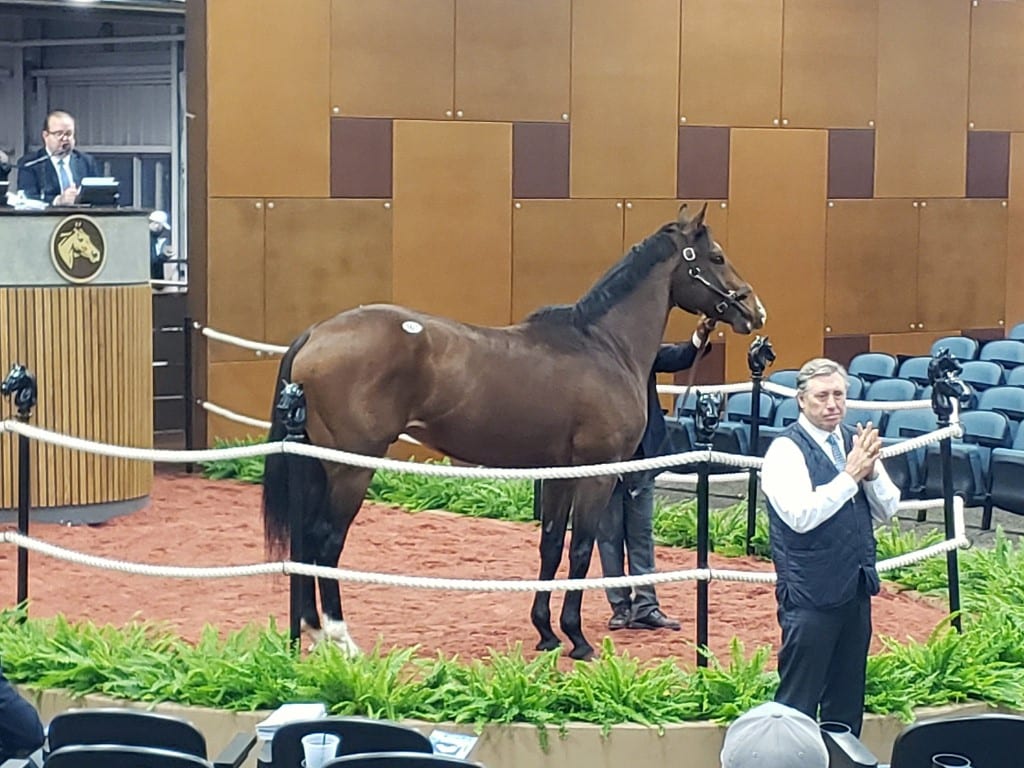WHAT’S IT WORTH TO VET A HORSE?

When buying a horse of racing age, what’s the premium buyers will pay to have the ability to vet it?
Put a different way: when claiming a horse, a trainer and owner are at the mercy of circumstance. Maybe they’re getting a perfectly sound horse, but then again, maybe they’re not; and all their due diligence still leaves a lot of gaps in their knowledge.
But at sales featuring horses of racing age – such as Tuesday’s Fasig-Tipton Midlantic mixed sale – the scales tip a bit towards the buyer, who not only has access to the horse’s past performances but also can vet them.
That should be worth something, so we wondered: how much was it worth?
At least based on Tuesday’s results, the answer is: some, but perhaps not as much as you might think.
There are, unsurprisingly, all sorts of caveats here. For one thing, the number of horses of racing age at any sale is too small to be representative of all sales. For another, the horse population varies considerably from sale to sale. And what the buyers now can see – how the horse vets and scopes, for example – those of us crunching numbers can’t.
Still, the information is interesting and, if nothing else, a data point to consider.
- Marksman Queen reigns in G3 Dick Memorial
 In a race that looked very much like her Keertana Stakes win, Marksman Queen led throughout to win the G3 Dick Memorial Saturday at Delaware Park.
In a race that looked very much like her Keertana Stakes win, Marksman Queen led throughout to win the G3 Dick Memorial Saturday at Delaware Park.
At the just completed sale, there were 16 horses who met the following criteria: they were being offered as racehorses only (knocking out those offered as racing/broodmare prospects); they had raced at some relatively recent point for a claiming tag (thus providing a somewhat objective measure of their value); and they actually sold at the sale (as opposed, for example, to receiving bids but failing to meet a reserve).
Those 16 sold for an average of $22,700. That was $1,262 more than their average recent claiming price. That suggests some premium, but not much.
The picture gets murkier as you drill down. Only five of the 16 horses actually sold for more than their recent claiming price, while another seven sold for between their recent claiming price and $2,000 less.
The high seller vis a vis recent claiming price was Hip 270, a three-year-old Cairo Prince colt named Chocolate Bar. He broke his maiden at the $40,000 level in August and fetched a winning bid of $80,000 Tuesday. In between, he finished second or third three straight times in allowance or high-priced starter allowance company.
On the flip side was Hip 246, a three-year-old Lucky Pulpit gelding named Strike It Lucky. He won in $50,000 claiming company for three-year-olds on the turf at Del Mar in November – he was entered for $45,000 that day – but sold for just $18,000 on Tuesday, a $27,000 decline in value. That decline likely is a result of a) his being a turf horse and b) his value having been inflated in that recent claiming race. In the start prior, against older runners, whom he’ll have to face exclusively going forward, he’d finished third at the $20,000 level.
Digging in a bit further, we took each of those horses with recent claiming efforts and sought to assess their true value today. So, for example, Hip 246 looks a lot more like a $20,000 horse than a $50,000 horse, given where he’ll have to run in future. And a horse that just won his final lifetime condition for, say, $10,000, now looks more like a $7,500 horse than a $10,000 horse.
- Edy’s Flame heats up in first CT 2yo race
 Edy’s Flame dominated Charles Town’s first 2yo race of the year, a somewhat surprising result even if bettors focused on the right connections.
Edy’s Flame dominated Charles Town’s first 2yo race of the year, a somewhat surprising result even if bettors focused on the right connections.
With those revised values, the premium goes up a bit. The 16 horses’ predicted racing value averages $20,125, and thus that $22,700 average sale price means that buyers paid a premium of $2,575.
As for racing/broodmare prospects – of which there were only eight that met our criteria, a group harder to assess without drilling into their broodmare potential – they actually sold for, on average, less than their recent claiming price. On Tuesday those eight brought an average price of $17,812 – more than $4,000 less than their most recent claiming tag of $21,937.
Seven of the eight went for a final price at least $5,000 different from their most recent claiming price, with half going for less than their recent claiming tag.
The limited data on racing/broodmare prospects seems to suggest a couple of facts. One is that in a tough market for mares — the average broodmare brought less than $5,100 – some owners may still overvalue their broodmare prospects. Two of the eight went for more than $20,000 less than their most recent claiming tag and five racing/broodmare prospects in our initial group received bids but did not meet their reserves.
A second is that while recent claiming price may be a reasonable guide to the value of horses of racing age, it’s likely of less value when assessing racing/broodmare prospects, since an indeterminate and variable amount of their value resides not on the racetrack but in the breeding shed.
Where does it all get us? Of course, you’d need to do a lot more research to get definitive results, and some horses – for example, lightly raced horses that appear to have the ability to take down one or more allowance conditions – will fall outside the predictive range. But it appears based on this first cut that a reasonable rule of thumb would be that the premium paid by buyers at the sale is, on average, between $1,000 and $3,000 above anticipated value on the track.
LATEST NEWS















